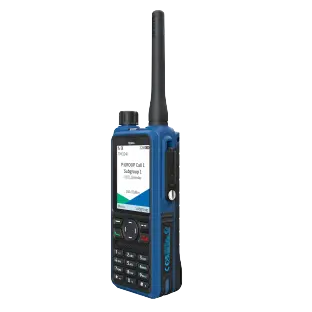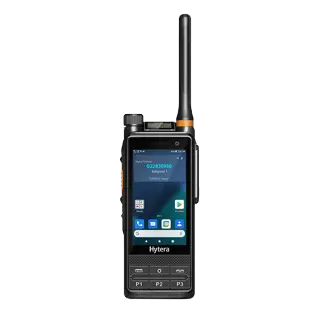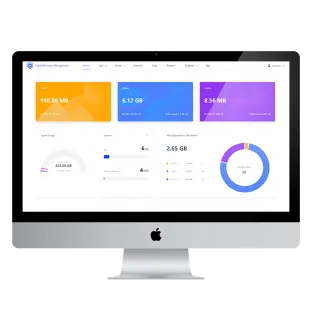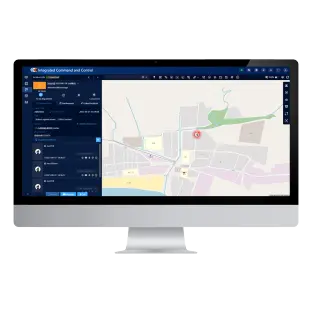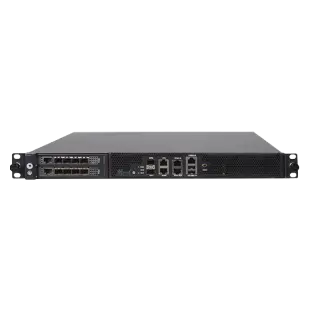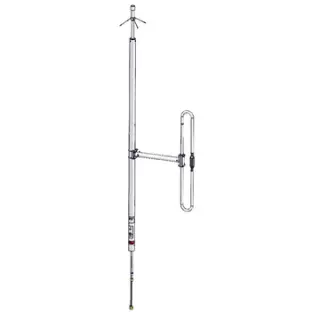This article reproduces an exclusive interview with Hytera CTO Sun Pengfei from the media "Foresight" under the Qianzhan Industry Research Institute.
2021 is a year of the booming digital economy, information and communication technology (ICT), and a year of growing 5G infrastructures, network intelligence (NI), and fiber broadband. Driven by 5G, it is also a year for PMR network to determine how and where it will be. PMR network may not be as well-known as the public network, while historically, PMR network came into being much earlier and was used in particular scenarios such as police radio communications.
Most people are less familiar with the PMR network than the public network. In fact, PMR network communication emerged earlier than public network communication. It was mainly used in certain particular scenarios, such as the radios used by the police for performing general duties.
Simply put, PMR networks are usually established to meet the needs of user organization management, safe production, dispatching, and command. PMR networks are more reliable and secure than public networks. They are mainly used in public security, public utilities, and industry and commerce. Their serving objects are large in scale, strong in strength, and have high PMR network communication products requirements.
The development of the telecommunication industry in China in recent years has spurred rapid growth in the market scale of PMR network communication. According to data released by the Qianzhan Industry Research Institute in April 2021, the market scale of China's PMR network communication reached US$ 2.5 billion in 2016 and US$ 5.3 billion in 2020, with an estimated amount of US$ 6.0 billion in 2021. PMR network communication is playing an essential role in the Chinese communication field.
Figure 1: Market Scale and Growth Rate of the Chinese PMR Network Communication Industry from 2012 to 2021 (Unit: US$ 100 million, %)
The rapid development of 5G technology has enabled network slicing, edge computing, and other technologies to achieve PMR communication on the public network. This has led some people to question whether the PMR network is necessary.
Regarding this point, the interview column "Foresight" of Forward-The Economist invited Mr. Sun Pengfei, the CTO of Hytera, to discuss the development direction and future trends of the PMR network under 5G.

Founded in 1993, Hytera is a leading global provider of professional communications technologies and solutions, ranking second in the global radio market. Over the past 20 years, Hytera has grown from a radio seller to a global high-tech enterprise offering advanced technologies such as TETRA, DMR, PDT, LTE, and 5G with mature applications.
Ⅰ, Will the PMR Network Be Replaced by the 5G Public Network?
In response to the above-mentioned doubts, Sun Pengfei said that setting aside the differences between the PMR network and the public network, the essence of communication is to transmit information to the destination in a timely, accurate, and secure manner. "Timely" includes two meanings. One is the ability to transmit (network controllable), and the other is the ability to deliver within the specified time (delay controllable). "Accurate" means no loss or error during transmission (controllable interference for licensed spectrum resource). "Secure" means that information is not stolen or tampered with during transmission.
Different user groups have different requirements for the preceding three factors, and different requirements have different costs. Therefore, two different types of networks are used: self-built PMR networks and operators' public networks.
The early PMR networks were constructed and maintained by users and mainly used narrowband large-cell coverage. They feature a controllable network, secure and reliable information transmission, and controllable transmission delay and meet the requirements of voice communication and the transmission of small amounts of data. Due to low network investment and O&M costs, PMR networks are cost-effective and affordable for users.
With the advent of the 4G era and the impact of high-speed and large-bandwidth services on the public network, PMR network users have potential requirements for broadband services. However, users face a wide range of problems when building large-bandwidth PMR networks, such as shortages of licensed spectrum resource and high network construction and O&M costs.
In addition, in the 4G era, the public network focuses on the development of mobile Internet and is geared towards the public rather than industry users. The information transmission timeliness, accuracy, and security of the public network cannot meet the requirements of public security user groups. Therefore, public network transmission is applied only to services with low timeliness requirements, such as query and unidirectional uploading and mobile police services with security measures.
With the advent of the 5G era, the public network provides a higher rate, shorter delay, and larger capacity, and its target groups are expanded to include industry users and device-to-device communication.
To meet industry users' requirements for the PMR network, 5G also supports the slicing technology to provide certain PMR network attributes. Because of this, someone again put forward the viewpoint that the public network will replace the PMR network. They think that the public network can meet all PMR network requirements, and the PMR network is no longer necessary.
That is actually not the case. The public network struggles to offer the following three features of the PMR network:
First, a controllable network.
Second, more secure communication.
Third, controllable delay.
These three features are fundamental requirements of the PMR network and are essential to industry users who use the PMR network, especially public security users.
Besides, PMR communication on the 5G public network has an irresolvable problem. Even though operators provide the theoretically feasible L4 slicing service for exclusive carrier frequencies, it is too expensive for operators to establish physically isolated and independent core networks and base stations for each industry user. The vast quantity of industry users and network investment increased by N times, making it difficult for operators to profit. Industry users are unable to invest or maintain these networks, which means that operators cannot make profits. PMR communication on the 5G public network only changes the investment subject from industry users to operators.
One idea is to share operators' physical networks and use logical division to provide low-level fully shared or partially-exclusive slicing (L2/L3). However, this violates the security redline of essential departments, such as public security. It is an unsolvable problem. Operators' 5G slicing, the Open Radio Access Network (O-RAN) with the base stations and some core networks established by users, and User Plane Function (UPF) deployment towards the edge can meet the broadband communication requirements of some industry users. In short, the PMR network does not reject 5G technology and needs to use 5G technology properly.
Finally, the narrowband PMR network and public network have a complementary relationship and will coexist for a long time. In the development of the PMR network, it is an inevitable trend that higher bandwidth must be provided. However, the relationship between broadband and narrowband is not a substitute but complementary.
The narrowband large-cell coverage PMR network has low network construction and O&M costs and is suitable for enabling users to build nationwide large networks themselves. However, the broadband small-cell coverage PMR network is suitable for small areas or hot spots. Although the broadband network can bear narrowband services in the coverage area, it is less cost-effective than the narrowband network. The combination of broadband and narrowband networks has higher cost-effectiveness. Therefore, Sun Pengfei believes that it is impossible for the public network to completely replace the PMR network at present. It is possible that the public network could replace the PMR network of some industry users who have low security requirements.
Ⅱ, Spectrum Resource is Key to Make Private 5G Network a Business Opportunity
Currently, it is impossible for the 5G public network to completely replace the PMR network. In addition, the vigorous development of the digital economy and the promotion of digital transformation has ushered in new opportunities for the PMR network industry.
Most critical communication users also believe that the industry PMR network is fully developed, and the future will not be exclusively dominated by the 5G public network. Under the background of intelligent manufacturing and digital transformation, private 5G networks will become a critical point of the use of 5G.
According to data from Grandview Research, the global market scale of private 5G networks was US$ 920 million in 2020, and the compound growth rate will reach 37.8% from 2020 to 2027. The market scale of the private 5G network increases rapidly with the demands of vertical customers. If the Chinese market accounts for 20% of the global market, the market scale of China's private 5G network will be close to US$ 2 billion or even larger by 2027.
Figure 2: Global private 5G network Market Scale from 2020 to 2027 (Unit: US$ 100 million) 
With regulation support and rapid industry development, Chinese device manufacturers, such as Huawei, ZTE, Ericsson, Inspur, and Hytera and Internet giants such as Alibaba and Tencent, have started constructing the private 5G network.
Due to the converged user requirements, the public network has always obtained a large amount of capital investment and iterated more rapidly. However, despite its longer history, the PMR network has struggled to develop on a large scale and obtained less capital investment due to scattered requirements, strong customization, and other factors.
As major device manufacturers and Internet giants preempted the private 5G network, the situation has changed. For this, Sun Pengfei thinks that the development of 5G can be seen from the development of 4G.
After nearly 10 years of development, the mobile Internet led by 4G has produced great economic benefits and brought profound changes to our lives. But 4G was also questioned in the early stages of development. At that time, many people thought that 3G was fast and enough. Was 4G really necessary? After smartphones and smartphone-based applications promoted the leapfrog development of the entire mobile Internet industry, this doubt has disappeared.
Sun Pengfei said that with the development of 5G, industry users who use PMR network communication will have explosively increasing requirements for video transmission and data transmission in routine scheduling and emergency scheduling. For example, smart manufacturing, smart energy, smart city fields will be important application scenarios of the private 5G network.
"According to Hytera's many years of experience in the PMR network, the key for making private 5G network a business opportunity lies in the spectrum resource." said Sun Pengfei. It is only with PMR network spectrum resource that industry users can build networks independently to achieve secure and controllable PMR networks. Otherwise, they will be subject to certain constraints.
All of the three major Chinese operators join the O-RAN Alliance. If industry users are willing to invest capital for constructing base stations, operators will no longer have the problem of prohibitively high base station costs and electricity fees. This indicates that industry users and operators have shared benefits. Operators certainly do not want to lose industry users, a major source of clients for them. Therefore, they have a trump card: spectrum resource.
At present, industry users' self-built private 5G networks need to use operators' spectrum resource and access operators' core networks. Industry users configure the UPF and Minimum Essential Communication (MEC) at most. If industry users are unable to pay high service fees or lose operators' support, or the link and core network are faulty, the self-built PMR network part is useless. If some public network base stations stop operations, the public is unlikely to notice because there are base stations all around and it does not matter if some base stations are shut down for a few minutes. However, if a PMR network stops running for even a few seconds, the loss is incalculable.
To solve this problem, users must be allowed to build their own core networks, even a simple standby core network, which can offer users a little sense of security.
III. Hytera Private 5G Network Empowers Digital Transformation of Vertical Industries
PMR communication has begun to integrate different industries on a large scale, and more application scenarios are generated.
Based on 30 years of experience in the PMR network communication field and thorough understanding of vertical customers' business scenarios and functional requirements, Hytera began to focus on how to use 5G innovative applications and business patterns to empower the industry 3 years ago. Sun Pengfei said that one of the values of the private 5G network is to empower digital transformation of the vertical industries.
Due to different vertical segmentation, there are many custom and differentiated industry requirements. Hytera needs to make full use of its technical and resource advantages in communication to become an example for making prototype points.
Hytera's 5G independent PMR network has achieved good practical effects in typical applications of three key industries: smart factory, smart mine, and smart port.
For example, in Hytera's own smart factory in Shenzhen, the visual inspection procedure in the SMT production line originally utilized manual inspection. Inspection of a single board took 2 to 3 minutes, and 10 lines needed at least 10 inspectors. The labour intensity was significant, and the false positive rate was difficult to be controlled within 5%. At present, 5G combined with edge computing is used for intelligent visual inspection. The average inspection time of a single board is shortened to less than 5s, the false positive rate is reduced to less than 1‰, and only two O&M personnel are required. Both the labour intensity and labour consumption are significantly reduced. The production efficiency and product quality are greatly improved.
In a large car factory in Nanjing, 2 workshops of tens of thousands of square meters are accommodated. It is difficult to ensure seamless coverage of the whole workshop using Wi-Fi. However, with the 5G wireless PMR network, the production and scheduling efficiency is significantly improved. More importantly, with the large bandwidth and low delay of 5G, more than 300 unattended intelligent dispatching and material transportation vehicles arrive at the exact positions on time to complete material transportation.
According to incomplete statistics, the transportation efficiency is improved by 50% and the cost is reduced by 30% when compared with labour. These are reference prototype points at the forefront of the industry.
In addition, these prototype points have a positive social effect. Hytera is also actively constructing the "5G+Industrial Internet Ecological Circle." With 30 years of industry experience and project experience as well as the use of industry-leading "pipeline" and "terminal" methods, Hytera actively empowers upstream and downstream partners to work together to serve this industry better and achieve mutually beneficial cooperation.
"This is also the basic idea behind Hytera's 5G+industrial Internet business." said Sun Pengfei.
Ⅳ, What Is the Market Trend of PMR Network in 2022?
How time flies. 2021 is over. Full of anticipation, we welcome a new year.
Looking forward to the new year, Sun Pengfei revealed some plans about Hytera.
First, since its inception in 1993, Hytera has focused on the PMR network field. Although Hytera's business has extended from initial narrowband communication to broadband and even 5G, Hytera's original aspiration will not change. Hytera will still be engaged in the PMR network field.
Second, Hytera hopes to get more development opportunities from 5G. In emerging markets, Hytera makes efforts to bridge the technology gap to provide more services to industrial customers.
Finally, Hytera will make some new attempts, such as deploying the Internet of Things (IoT) to explore more industry opportunities.
In predicting the trends of the PMR network market in 2022, Sun Pengfei remarked that with strong policy support, the private 5G network will usher in rapid development. Although some of the problems mentioned above and difficulties exist, more enterprises will be a part of this industry in the new year to jointly solve these problems. Especially through exploration for a certain period of time, industry customers, PMR network manufacturers, and operators will find better solutions to cooperate with each other.
"In a word, the private 5G network has a bright future and good opportunities."





